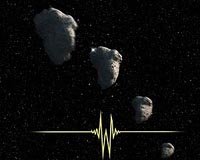 |
Williamstown MA (SPX) Jun 21, 2010 A large group of scientists, including Jay Pasachoff, Bryce Babcock, and Steven Souza at Williams College, reveal the character of one of the most distant objects in the solar system in a scientific paper to appear in the journal Nature. In observing the object named 2002 TX300 October 9, 2009, as it passed in front of a distant star, they could tell what its surface is like and its size. For several years, Pasachoff, Babcock, and Souza have worked with James Elliot and Michael Person of MIT and Amanda Gulbis of the South African Astronomical Observatory in studying Pluto. With careful measurements of a star's brightness as Pluto hides or occults it, they have shown that Pluto's atmosphere was slightly warming or expanding. A main goal is to find out how its atmosphere is now changing, especially with a NASA spacecraft to Pluto en route. After successful observations of Pluto and its largest moon, Charon, the MIT-Williams team expanded its horizons. Measurements by others of the orbits of several objects discovered beyond Neptune and Pluto had revealed that the object 2002 TX300 was to pass in front of a star; the stars are all so far away that the shadow of the object in starlight on the Earth is the same diameter as that of the object itself. Since predictions of the shadow path had uncertainties of perhaps thousands of miles, the MIT-Williams team set up a network of 21 telescopes from as far north as the western United States mainland and as far south as Mt. John in New Zealand. On October 9, three important measurements were made with telescopes operated or arranged by Pasachoff, Babcock, and Souza, aided by Williams student Katie DuPre '10, who joined Babcock on the Hawaiian island of Oahu. The best observations came from a telescope of two meters diameter of the Las Cumbres Observatory Global Telescope Network located at an altitude of 10,000 feet at Haleakala Crater on Maui, Hawaii. Pasachoff coordinated these observations with Wayne Rosing and his colleagues there. The Nature article includes a graph of these observations along with those from the Big Island of Hawaii and from Oahu. The team's success satisfies a long-term goal of Elliot, who used the occultation method to discover the rings of Uranus decades ago and continues to champion the method. After analysis by Elliot, Person, and colleagues at MIT, the conclusion was clear: 2002 TX300 (also known as 55636 in the numbering scheme of asteroids and other small bodies in the solar system) was much smaller than had first been thought. Its radius is about 89 miles, with an uncertainty of only three miles (143 kilometers with an uncertainty of only five kilometers). Since it is so small, it must be reflective and covered with ice to appear as bright as it does. The joint article in Nature, with 41 coauthors that included the observers from all the telescopes, is titled "An Old World with a Fresh Surface." The calculations show that 2002 TX300 is the shiniest object known in the solar system, reflecting 88 percent of the sunlight that hits it. The measurement confirms that it is one of several fragments knocked off Haumea - one of the three known dwarf planets beyond Pluto - by a collision. (Pasachoff worked during 2008-09 on sabbatical at the California Institute of Technology with Michael Brown, the discoverer of Haumea and many of the other objects in that realm, in trying to use similar techniques to study Haumea and one of its moons as they occulted each other.) The Nature article describes other calculations that show that the collision that split Haumea occurred about a billion years ago. That age raises the question as to how such a young, icy surface arose on such an old object. Some of the observations meant to study 2002 TX300 used a camera system, designed in a collaboration of Babcock and Souza with MIT colleagues, known as POETS, for Portable Occultation, Eclipse, and Transit System. A grant from NASA provided three POETS each for Williams and MIT. The recent observations were supported by a grant to Williams from NASA's Planetary Astronomy Division.
Share This Article With Planet Earth
Related Links Williams College The million outer planets of a star called Sol
 Coordinated Stargazing
Coordinated StargazingBoston MA (SPX) Jun 18, 2010 Far beyond the orbit of Neptune in a region of the outer solar system known as the Kuiper Belt float thousands of icy, moon-sized bodies called Kuiper Belt objects (KBOs). Astronomers think they are the remnants of the bodies that slammed together to form the planets more than 4 billion years ago. Unlike Earth, which has been continually eroded by wind and water since it was formed, KBOs haven't ... read more |
|
| The content herein, unless otherwise known to be public domain, are Copyright 1995-2010 - SpaceDaily. AFP and UPI Wire Stories are copyright Agence France-Presse and United Press International. ESA Portal Reports are copyright European Space Agency. All NASA sourced material is public domain. Additional copyrights may apply in whole or part to other bona fide parties. Advertising does not imply endorsement,agreement or approval of any opinions, statements or information provided by SpaceDaily on any Web page published or hosted by SpaceDaily. Privacy Statement |